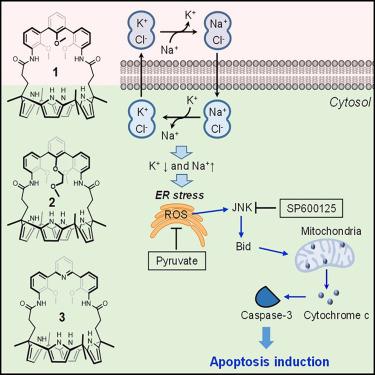Chem ( IF 23.5 ) Pub Date : 2021-09-14 , DOI: 10.1016/j.chempr.2021.08.018 Sang-Hyun Park 1 , Inhong Hwang 2 , Daniel A. McNaughton 3 , Airlie J. Kinross 3 , Ethan N.W. Howe 3 , Qing He 4 , Shenglun Xiong 4 , Martin Drøhse Kilde 2 , Vincent M. Lynch 2 , Philip A. Gale 3, 5 , Jonathan L. Sessler 2 , Injae Shin 1

|
A number of artificial cation ionophores (or transporters) have been developed for basic research and biomedical applications. However, their mechanisms of action and the putative correlations between changes in intracellular cation concentrations and induced cell death remain poorly understood. Here, we show that three hemispherand-strapped calix[4]pyrrole-based ion-pair receptors act as efficient Na+/K+ exchangers in the presence of Cl− in liposomal models and promote Na+ influx and K+ efflux (Na+/K+ exchange) in cancer cells to induce apoptosis. Mechanistic studies reveal that these cation exchangers induce endoplasmic reticulum (ER) stress in cancer cells by perturbing intracellular cation homeostasis, promote generation of reactive oxygen species, and eventually enhance mitochondria-mediated apoptosis. However, they neither induce osmotic stress nor affect autophagy. This study provides support for the notion that synthetic receptors, which perturb cellular cation homeostasis, may provide new small molecules with potentially useful apoptotic activity.
中文翻译:

合成的 Na+/K+ 交换剂通过扰乱细胞阳离子稳态促进细胞凋亡
许多人工阳离子离子载体(或转运蛋白)已被开发用于基础研究和生物医学应用。然而,它们的作用机制以及细胞内阳离子浓度变化与诱导细胞死亡之间的假定相关性仍然知之甚少。在这里,我们表明,在脂质体模型中,在Cl -存在的情况下,三个半球缠绕的杯[4]吡咯离子对受体可作为有效的 Na + /K +交换器,并促进 Na +流入和 K +流出(Na + /K +交换)在癌细胞中诱导细胞凋亡。机理研究表明,这些阳离子交换剂通过扰乱细胞内阳离子稳态,促进活性氧的产生,最终增强线粒体介导的细胞凋亡,从而在癌细胞中诱导内质网 (ER) 应激。然而,它们既不诱导渗透压力也不影响自噬。这项研究为以下观点提供了支持,即扰乱细胞阳离子稳态的合成受体可能会提供具有潜在有用的凋亡活性的新小分子。



























 京公网安备 11010802027423号
京公网安备 11010802027423号